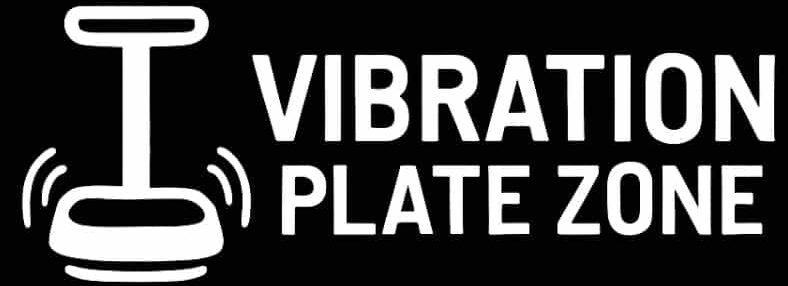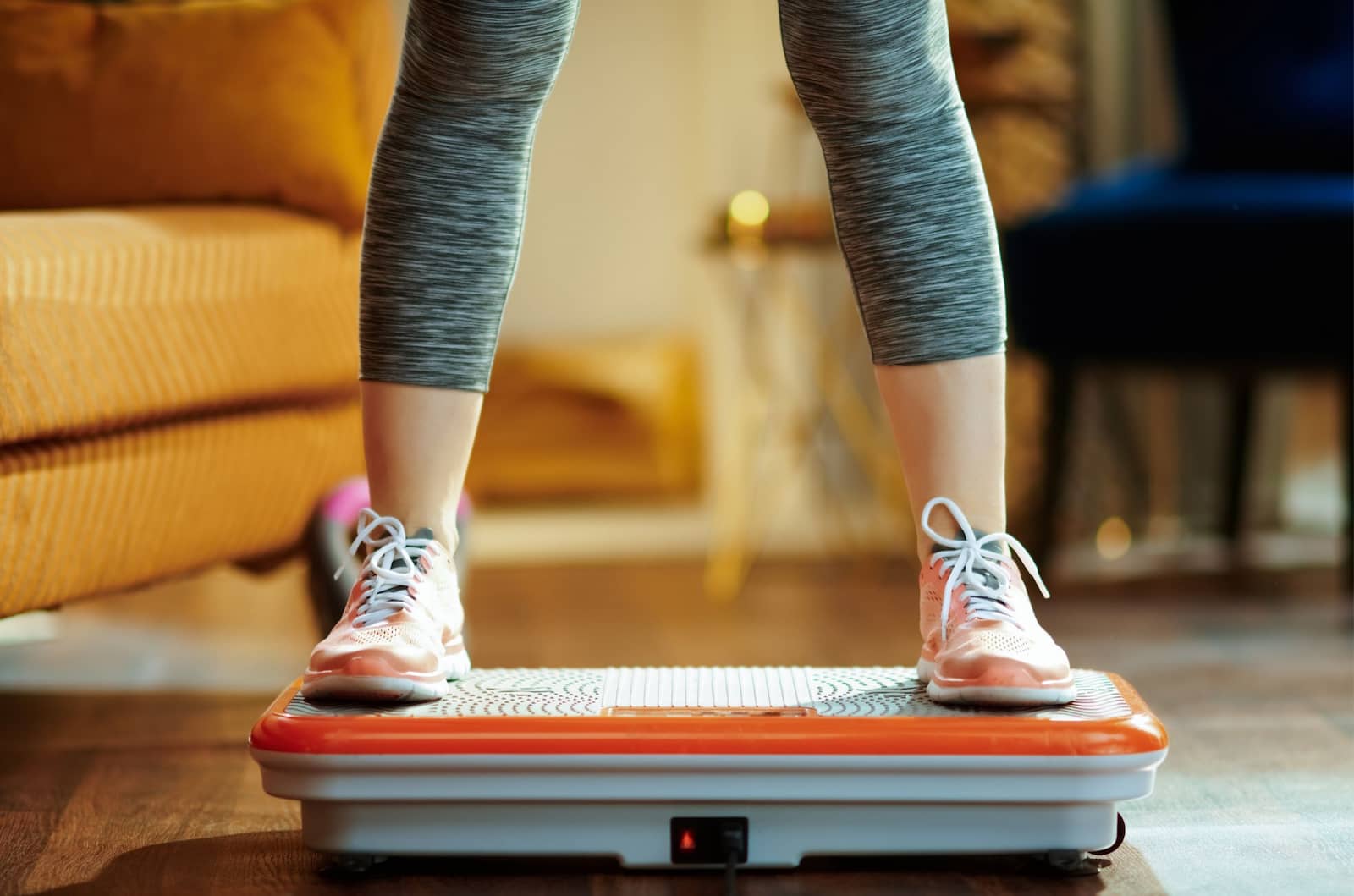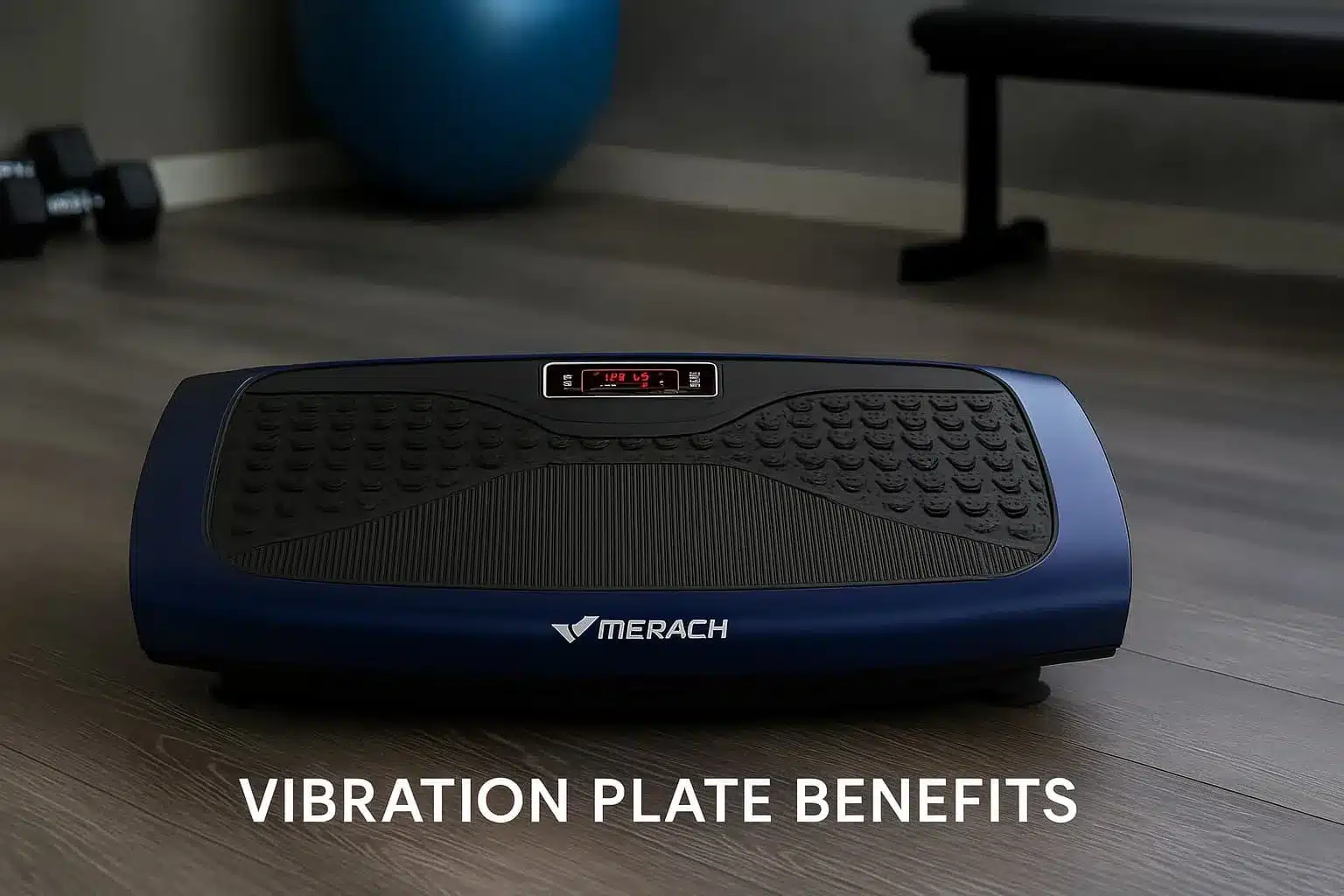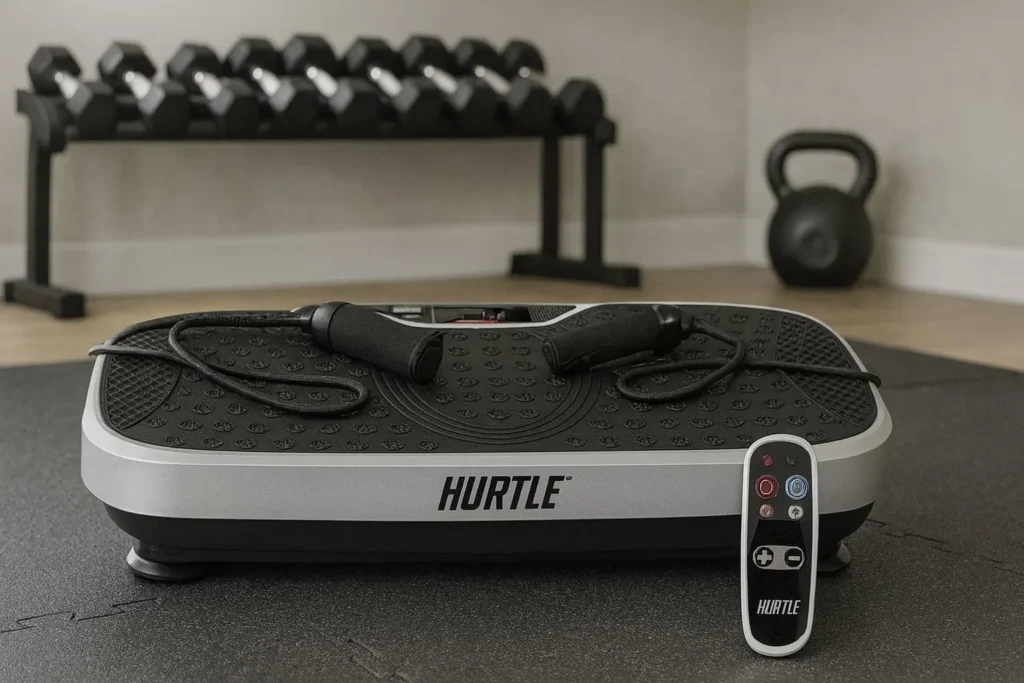So, what is a vibration plate, and why do so many gyms and home fitness setups have one now? In short, it’s a machine that makes a platform shake at controlled speeds and ranges. When you stand, sit, or exercise on it, those vibrations travel through your body and force your muscles to contract over and over again. Sounds simple, right?
But the effects can be surprisingly powerful. I’ve used them myself with clients and personally before runs, and I’ll break down what they actually do, how to use them without overdoing it, and when to skip them.
What Is a Vibration Plate? The (Not So) Short Answer

A vibration plate is a piece of fitness equipment with a flat surface that moves rapidly, either side to side or up and down. This movement causes your muscles to react reflexively, firing repeatedly to stabilize you. That’s why even a short session can feel like you’ve worked harder than you expected.
Research backs this up. A meta-analysis in the Journal of Strength and Conditioning Research found real strength improvements, especially in the lower body, when vibration training was paired with regular workouts (Journal of Strength and Conditioning Research).
In practice, vibration plates are often used in gyms, rehabilitation centers, and even home settings because they provide a low-impact way to stimulate muscles. The constant micro-adjustments your body has to make activate stabilizer muscles that don’t always get targeted in traditional workouts. This is why vibration training is sometimes described as “neuromuscular training,” since it strengthens the connection between your nervous system and muscles.
Beyond strength, research suggests vibration plates may support bone density maintenance, especially in older adults, by stimulating bone remodeling processes in a similar way to weight-bearing exercise. They’re also being studied for circulation benefits, since the rhythmic contractions help blood flow and lymphatic drainage.
That’s why you might see vibration plates marketed not just for athletes but also for seniors, people in physical therapy, or those looking to complement traditional routines with vibration plate exercises.
What Is a Vibration Plate Good For?
A vibration plate is good for enhancing muscle strength and endurance without the need for heavy lifting. The rapid vibrations trigger reflexive muscle contractions, which can engage more muscle fibers than traditional exercise. This makes it a useful option for both beginners and athletes looking to complement their workouts.
The best vibration plates for lymphatic drainage are also effective for improving circulation, which supports faster recovery and reduces swelling in the body. The mechanical vibrations stimulate blood flow and lymph movement, helping to remove waste products and deliver nutrients more efficiently. Many people use it after long periods of sitting or inactivity.
Another benefit is its role in weight management and fat reduction. Research shows that regular vibration training can support calorie expenditure, improve metabolism, and help reduce body fat when combined with a healthy lifestyle. While it is not a magic solution, it can be a supportive tool for those seeking body composition improvements.
Finally, vibration plates are good for increasing flexibility and mobility, especially in people with stiff joints or limited range of motion. The vibrations loosen muscles, improve tissue elasticity, and make stretching more effective. This makes it particularly valuable for older adults and those in rehabilitation settings.
What Is a Vibration Plate Used For?
A vibration plate is commonly used for fitness training and exercise enhancement. People stand, squat, or perform simple movements on the platform while it vibrates, amplifying the effects of their workout. This provides a low-impact way to build strength, improve balance, and support endurance training.
It is also widely used in rehabilitation and recovery programs. Physical therapists and trainers may recommend vibration plates for individuals recovering from injury or surgery. The gentle stimulation helps maintain muscle activity, promotes circulation, and prevents stiffness during the healing process.
Another use is in wellness and lymphatic health, where vibration plates support drainage and fluid movement. Individuals with mild swelling or heaviness in their legs often find relief through short sessions. By encouraging natural lymphatic flow, vibration training can help reduce discomfort and improve overall energy levels.
In addition, vibration plates are used for bone health and osteoporosis prevention. The mechanical stress created by vibrations stimulates bone remodeling and density improvements. For older adults or those at risk of bone loss, this provides a safe, joint-friendly method of maintaining skeletal strength.
History of Vibration Plates
Early Origins and Invention
The concept of vibration training can be traced back to the mid-20th century. The earliest form of a vibration plate was developed in the 1960s by Russian scientist Vladimir Nazarov, who used mechanical vibrations to help cosmonauts maintain muscle strength and bone density during long periods in space. Known as "biomechanical stimulation," this early technology was designed to counteract the effects of weightlessness and muscle atrophy. The results showed promise, laying the foundation for what would later become modern vibration training.
From Space Technology to Sports and Medicine
After proving successful in space programs, vibration training gradually found its way into sports science and rehabilitation settings. Elite athletes and professional sports teams began experimenting with vibration platforms to improve strength, flexibility, and recovery times. By the 1980s and 1990s, physical therapists also adopted the technology to help patients with mobility issues, osteoporosis, and circulation problems. This transition from space research to medical and athletic applications was a critical step in making vibration plates accessible beyond highly specialized environments.
Commercial Rise in the 1990s and 2000s
Vibration plates began gaining mainstream attention in the late 1990s and early 2000s. Companies like Power Plate played a key role in bringing the technology to gyms, wellness centers, and eventually private homes. Marketing efforts emphasized vibration plate benefits such as improved muscle tone, weight management, and circulation, which appealed to both fitness enthusiasts and people seeking low-impact exercise. As awareness grew, vibration plates started appearing in commercial fitness facilities around the world, setting the stage for wider consumer adoption.
Popularity in the Consumer Market
By the mid-2000s, vibration plates had become one of the most talked-about fitness trends, especially as compact and more affordable models entered the consumer market. Television segments, celebrity endorsements, and fitness magazines helped boost their popularity.
Home-use vibration plates became attractive for people wanting efficient workouts with minimal time commitment. While some critics questioned exaggerated claims, the appeal of convenience and versatility drove steady growth in sales, making vibration plates a common sight in households as well as gyms. The best vibration plate for home use is now just a few clicks away.
Leading Manufacturers Today
Today, vibration plates are widely used for fitness, rehabilitation, and general wellness. Some of the most recognized manufacturers of the best vibration plates include Power Plate, which remains an industry leader; Hypervibe, known for its science-backed designs; LifePro, which has gained popularity in the consumer space for offering affordable and feature-rich models; and Bluefin Fitness, a UK-based company specializing in home fitness equipment. Other notable brands include Confidence Fitness and NexHT, which target entry-level users. Together, these manufacturers continue to innovate, offering a wide range of machines designed for different needs, from professional athletes to casual home users.
Early Scientific Foundations
The scientific roots of whole body vibration (WBV) workouts lie in the 1960s, when Nazarov explored mechanical vibrations as a way to stimulate muscle contractions. His research demonstrated that exposing the body to specific frequencies could activate neuromuscular reflexes, leading to improved muscle performance even in low-gravity environments. This work was primarily aimed at helping Soviet cosmonauts maintain strength and bone density during extended space missions, where muscle atrophy and skeletal loss posed serious challenges.
Adoption in Space and Rehabilitation Programs
Following Nazarov’s success, vibration training was adopted as a tool for space medicine. Cosmonauts used WBV platforms to counteract the physiological decline caused by weightlessness, and results showed improvements in muscle preservation and bone health. Outside of space programs, medical researchers began studying its applications in rehabilitation settings. Patients recovering from injuries or suffering from mobility-related conditions found that vibration training could stimulate circulation, support bone density, and encourage gentle muscle engagement, making it a valuable complement to physical therapy.
Transition to Sports Science
By the 1980s and 1990s, WBV attracted attention in sports science. Researchers discovered that vibration exposure could enhance athletic performance by improving strength, flexibility, and neuromuscular coordination. Professional athletes and trainers began experimenting with vibration workouts to accelerate recovery, improve power output, and reduce the risk of injuries. Studies also suggested potential benefits for hormonal balance, such as increased growth hormone and reduced cortisol levels, further strengthening the case for its use in competitive sports.
Medical Research and Health Applications
But, do vibration plates work? Well, scientific studies expanded into broader medical applications, with WBV investigated as a supportive therapy for conditions like osteoporosis, arthritis, and circulation disorders. In addition, the best vibration plate for neuropathy can do marvells if used consistently.
Furthermore, research indicated that the best vibration plates for osteoporosis can help increase bone mineral density, stimulate blood flow, and improve muscle activity in populations such as older adults suffering from osteoporosis and in individuals with limited mobility.
These findings opened the door to WBV being considered not only a fitness routine but also a therapeutic intervention in preventive medicine and rehabilitation programs.
Building the Foundation for Modern Fitness Use
The convergence of space science, medical research, and sports applications laid the groundwork for modern WBV workouts. By demonstrating measurable improvements in strength, circulation, bone health, and overall physical function, scientists and practitioners created a strong foundation for vibration plates to move into the mainstream fitness market. Today’s machines are a direct result of decades of scientific exploration, making whole body vibration workouts a unique blend of space-age innovation, medical therapy, and athletic performance science.

Notable Recent Studies of Vibration Plate Benefits
1. Chronic Low Back Pain Relief
A 2023–2024 systematic review and meta-analysis conducted by Zhang et al. examined the effects of whole-body vibration exercise (WBVE) on individuals with non-specific chronic low back pain. Covering outcomes such as pain intensity, physical function, proprioception, postural stability, and quality of life, the findings revealed significant pain reduction, improvements in daily function and proprioception, and enhanced physical performance with postural stability also improving in a majority of studies. Importantly, there were no reported adverse events, underscoring the therapy’s safety when used as part of a multimodal approach. View the study.
2. Enhancements in Muscle Strength and Lower-Body Performance
A 2024 systematic review of 21 randomized controlled trials by Zhou and colleagues found that WBV significantly improved lower-body strength and jump performance in postmenopausal women, compared with non-exercising controls. Additional meta-analysis and research from 2023–2024, led by various sports science and gerontology researchers, reinforce the strength, power, and physical performance benefits of WBV in older populations. Read the research.
3. Circulation, Recovery, Flexibility, and Bone Density Support
Clinical notes from institutions such as the Mayo Clinic and several peer-reviewed health studies consistently link WBV to improved circulation and lymphatic drainage, which can aid muscle recovery and flexibility. Research conducted by health and rehabilitation specialists at Healthline also indicates that when layered onto light exercise, vibration therapy may modestly maintain or improve bone mineral density, particularly in postmenopausal women. Learn more here.
4. Cognitive, Metabolic, and Fat Reduction Promise
Emerging evidence highlights broader health advantages of vibration training. A recent U.S. study by Hamer, Ćurčić-Blake, van der Zee, and colleagues (2025) investigated cortical activation and cognitive performance during whole-body vibration (WBV). Using functional near-infrared spectroscopy (fNIRS), they showed that WBV at 12 Hz and 24 Hz enhanced executive function and focus, as measured by improved Stroop task performance.
Alongside these cognitive benefits, a clinical trial by Vissers et al. (2009) demonstrated that WBV combined with calorie restriction led to significant visceral fat reduction and sustained weight loss over six months, sometimes outperforming aerobic exercise in obese adults. Together, these findings suggest that WBV can play a role in both mental performance and body composition improvements. Read the fat reduction study.
5. Inflammation, Immune Response, and Rehabilitation Applications
A 2024 meta-analysis by Guo et al. investigated WBV’s anti-inflammatory effects, including changes to biomarkers like interleukin-1β, tumor necrosis factor-α, and C-reactive protein, in both preclinical and clinical settings. Another preliminary trial led by Chen et al. applied WBV training to early-stage knee osteoarthritis patients, showing promising functional outcomes.
Additionally, animal-model studies from immunology researchers indicated WBV may modulate immune responses and even beneficially alter gut microbiota, suggesting potential broader metabolic and anti-inflammatory health impacts. Explore the study.

How a Vibration Plate Works
The magic of a vibration plate comes down to three numbers:
Frequency (Hz): how many times per second the plate vibrates
Amplitude (mm): how far the platform moves each time
Time: how long you stay on it
Together, these numbers create acceleration, often described as g-force. The higher the frequency and amplitude, the more your body feels it. Most research looks at settings between 15–60 Hz and amplitudes of 1–10 mm (Frontiers in Physiology).
The acceleration caused by these parameters can range from mild, equivalent to walking, to very intense, equivalent to sprinting or jumping. To put it into perspective, an amplitude increase of just 2–3 mm can nearly double the intensity of muscle contractions at certain vibration plates frequencies.
This is why vibration plates are often categorized by their intended use: light therapy and recovery devices typically have lower ranges, while high-performance models push into the higher end of the spectrum.
What your body does
So, do vibration plates work? Well, when the platform moves, your body resists that movement automatically. This triggers what’s called the “tonic vibration reflex,” causing your muscles to contract rapidly. That’s why standing in a squat hold for 30 seconds on the plate feels harder than just standing on the floor. In fact, studies show these reflexive contractions can help improve strength and performance (PLoS ONE 2024 Meta-analysis).
The tonic vibration reflex engages both slow-twitch and fast-twitch muscle fibers, something most exercises don’t achieve simultaneously. This combination has been linked to improvements in muscular endurance, explosive power, and recovery. For example, athletes often use vibration plates as part of warm-up routines because the rapid contractions activate muscles without requiring high physical strain.
Another key aspect is how the nervous system responds. Vibration training increases proprioceptive feedback; the body’s ability to sense its position and movement in space. This has practical applications in improving balance, coordination, and stability, which is why vibration plates are increasingly used in fall-prevention programs for seniors and in rehabilitation after lower-limb injuries.
Which frequencies matter
Lower ranges (10–20 Hz) are often used for balance and mobility drills. Middle ranges (20–45 Hz) are common in strength-focused studies. Personally, I usually keep people in the middle range because it’s where the best balance of comfort and benefit seems to happen.
At the lower range, the gentle oscillations don’t overstimulate the nervous system but still provide enough challenge to improve balance and joint mobility. These settings are also used in clinical applications where safety and tolerance are priorities. In the mid-range, vibration stimulates both neural and muscular responses, making it effective for hypertrophy, strength, and athletic performance.
The higher frequencies, closer to 60 Hz, are typically reserved for short bursts of training and advanced users, as they can be too intense for general fitness or rehabilitation.

Amplitude and g-force
Amplitude is how much the plate moves. A few extra millimeters may not sound like much, but your body feels it right away. Because g-force ramps up quickly with frequency and amplitude, tiny adjustments can make a big difference. That’s why I always suggest starting low and working your way up.
For example, a frequency of 30 Hz with a 2 mm amplitude may generate about 2 g of force, while the same frequency with a 6 mm amplitude can exceed 5 g. That’s more than double the intensity with only a few millimeters of additional movement. This explains why beginners are advised to use low settings until their body adapts, while athletes and experienced users often push higher for maximum effect.
High amplitude training can be especially beneficial for stimulating deep muscle tissues and bones, while lower amplitudes are preferred for recovery, circulation, and light training. Safety also comes into play and I always stress the potential dangers of vibration machines; excessive g-force without proper progression can lead to joint discomfort or fatigue. Structured progression, just like in weight training, is the safest and most effective way to use vibration plates.
Types of Vibration Plates
Not all vibration plates are the same. Here’s the main breakdown:
| Feature | Pivotal/Oscillating Plate | Linear/Tri-Planar Plate |
|---|---|---|
| Movement pattern | Tilts side to side like a seesaw | Moves mostly up and down (sometimes multi-directional) |
| Frequency range | Lower (often 5–30 Hz) | Higher (up to 50–60 Hz) |
| Amplitude | Higher, up to 10 mm or more | Lower, usually 1–4 mm |
| Feel | Gentler, rocking motion | More intense, vertical vibration |
| Best for | Balance, mobility, circulation, rehab use | Strength, power, short intense bouts |
| Comfort level | Usually easier for beginners and seniors | Feels stronger, can be challenging at high settings |
| Common settings | Low to moderate frequency with longer holds | Short bouts at moderate to high frequency |
| Typical users | General fitness, older adults, people new to WBV | Athletes, those focused on strength and performance |

Benefits You Can Expect
From my experience, pivotal plates are more beginner-friendly, while linear plates pack more punch for short, strength-driven sessions.
Here’s what the science (and my own coaching experience) says you can realistically get out of vibration training.
Strength and power
Studies show real gains in lower-body strength when WBV is used with exercise. A 2024 review focused on women confirmed improvements in muscle performance compared to controls (PLoS ONE). I use it with clients who need joint-friendly training, and they often feel stronger in their legs within weeks.
The strength benefits are tied to how vibration plates activate fast-twitch muscle fibers more efficiently than traditional static holds. These fibers are responsible for explosive movements like sprinting and jumping. When combined with squats, lunges, or planks on a plate, the neuromuscular system is forced to adapt, leading to measurable strength gains in shorter timeframes.
In athletes, this translates to improved vertical jump and sprint performance, while in everyday users, it shows up as being able to climb stairs more easily or carry groceries with less fatigue.
Balance and mobility
This is where vibration plates shine for seniors. Reviews show older adults improve balance and functional tests with consistent WBV (Frontiers in Physiology). I’ve seen this firsthand with clients who feel steadier during daily activities.
The improvements in balance come from enhanced proprioception; your body’s awareness of where it is in space. The small, rapid adjustments required on the plate train your ankle, knee, and hip stabilizers, which are crucial for preventing falls. Over time, this can reduce the risk of injury and improve independence.
For mobility, vibration plates help reduce joint stiffness by stimulating blood flow and gently stretching connective tissues. This makes everyday tasks like bending, walking on uneven ground, or standing up from a chair easier and safer.
Bone health
Bone density is tricky, but there are promising results. A meta-analysis in Osteoporosis International reported that WBV improved bone mineral density in postmenopausal women (Osteoporosis International).
A more recent study in Braz J Med Biol Res found that WBV showed potential in improving BMD and relieving pain in postmenopausal women with osteoporosis (Braz J Med Biol Res 2024).
Another overview concluded that while evidence is mixed, higher-quality trials found significant lumbar spinal improvements in postmenopausal women using high-frequency, low-magnitude WBV protocols.
Circulation and recovery
Ever notice a tingling sensation on your legs or feet during use? That’s blood flow. Some people also feel less sore after workouts when they add short vibration sessions.
Increased circulation helps deliver oxygen and nutrients to working muscles while speeding up the removal of metabolic byproducts like lactic acid. This explains why recovery feels faster and soreness less intense.
Athletes often use vibration plates post-training as a form of active recovery, while in rehabilitation, the enhanced circulation may help with swelling reduction and healing after injury.
Lymphatic drainage is another benefit, as vibration encourages the body’s natural fluid movement, which can reduce bloating and water retention.
Flexibility
Quick warm-up bouts can improve range of motion. I like using a plate before squats or lunges to loosen stiff ankles and hips.
The vibrations cause muscles and tendons to relax through neuromuscular reflexes, which reduces tension and stiffness. Research shows that even a few minutes on a vibration plate can increase flexibility in hamstrings, hips, and shoulders. This makes it a useful tool for both warm-ups and cool-downs. For people with tight muscles from sitting or limited activity, vibration plates provide a time-efficient way to prepare the body for movement without long stretching sessions.
Fat loss reality check
A vibration plate isn’t a fat-loss machine. Any weight changes come down to diet and overall activity. Think of WBV as a support tool, not a shortcut.
That said, the best vibration plate for weight loss increases energy expenditure considerably compared to standing still, and when used with bodyweight or resistance exercises, it can contribute to calorie burn. Some studies suggest small improvements in body composition when combined with diet and exercise, but the plate alone won’t “melt fat.” Its real value lies in making workouts more efficient, engaging more muscles at once, and potentially helping users stick to a routine thanks to variety.
Who Should and Shouldn’t Use One
Good candidates
- Beginners who need a low-impact training option
- Seniors focused on balance and bone health
- People looking to spice up their workouts with variety
For beginners, vibration plates provide a way to train safely without high impact on joints, making them ideal for overweight individuals or those returning to exercise. For seniors, the balance and bone-density benefits are well-documented, while fitness enthusiasts use them to add an extra challenge to routine exercises.
Use with caution
If you’re pregnant, have a pacemaker, implants, blood clotting issues, recent surgery, or severe migraines, get medical clearance first. The American Geriatrics Society also advises screening fall-prone seniors before new balance training.
These cautions exist because vibration can affect circulation, bone structures, and implanted devices. Pregnant women are advised to avoid whole-body vibration due to potential risks to fetal development, while those with cardiovascular or neurological conditions may experience unwanted side effects. Medical guidance ensures safe use in these cases.

How to Use a Vibration Plate
Want to learn how to use a vibration plate? Here’s a safe routine I teach beginners:
- Stand on the platform with soft knees and tall posture.
- Start with 2 minutes of gentle vibration at low settings.
- Do 3–6 bouts of 20–45 seconds of holds or simple moves.
- Rest as needed and finish with 1–2 minutes of light standing.
- Flat shoes or barefoot both work just make sure you feel stable.
This approach gives the nervous system time to adapt while reducing the risk of dizziness or muscle fatigue. Over time, adding dynamic moves like lunges, push-ups, or single-leg balances can significantly enhance results.
A Four-Week Beginner Plan
- Week 1: Learn the feel with stance holds, calf raises, planks.
- Week 2: Add step-holds and lunges.
- Week 3: Extend bouts and try single-leg balance.
- Week 4: Mix higher-frequency strength sets with lower-frequency recovery sets.
Most sessions last 12–15 minutes. That’s plenty.
The progression mirrors traditional exercise programming, with gradual increases in intensity, complexity, and duration. This ensures consistent adaptation without overloading joints or muscles. The varied settings also prevent plateaus by alternating between strength, balance, and recovery sessions.

Buying Guide
If you’re shopping, here’s what matters most:
- Type: Pivotal is more comfortable; linear is stronger
- Frequency range: Aim for up to 35 Hz for versatility
- Size: Wide platform and rails add stability
- Noise: Quieter motors are better for apartments
- Support: A solid warranty and clear manual are non-negotiable
Other factors include weight capacity, portability, and preset program options. High-quality plates use commercial-grade motors that can handle daily use, while cheaper models may struggle with consistency. Investing in a reliable plate ensures smoother vibrations, longer lifespan, and better safety.
Here are some of the specs that matter as well as a comparison of four popular models:
| Feature / Spec | LifePro Rumblex Vibration Plate | Power Plate MOVE | LifePro Rhythm Vibration Plate | Merach Vibration Plate MR-2489 |
|---|---|---|---|---|
| Weight | 42 lb | 87 lb | 63 lb | 22 lb |
| Dimensions | 31" × 18" × 6" | 30" × 24" × 9" | 30" × 15" × 9" | 20" × 13" × 5" |
| Speed / Levels | 60 speed levels | 6 frequency modes | 99 speed levels | 99 speed levels |
| Vibration Type | 4D multi-directional | Tri-planar | Vertical oscillation | Vertical oscillation |
| Max User Weight | 330 lb | 300 lb | 330 lb | 330 lb |
| Accessories Included | Remote, bands, mat | Remote, mat optional | Handles, remote, bands | Remote, bands |
| Best For | Deep stimulation & balance | Recovery & strength | Stability & circulation | Compact, entry-level use |
Common Problems
- Feet tingle: lower the amplitude or shorten bouts
- Knees shaky: keep knees soft and chest up
- Head buzz: move feet inward, reduce amplitude
- No effect: add a small bump in frequency or use isometric holds
These issues are common for beginners and usually resolve with adjustments. For example, standing with locked knees amplifies vibrations up the body, leading to discomfort. Proper form, knees slightly bent, core engaged, makes a big difference in comfort and effectiveness.
Myths to Avoid
- It doesn’t replace exercise, it supports it.
- It doesn’t “melt fat”; calories and diet still matter.
- Cranking up the settings isn’t always better.
Marketing often oversells vibration plates as miracle machines, but the science shows they’re most effective as part of a well-rounded fitness plan. Used correctly, they enhance workouts, speed recovery, and support health goals but they don’t replace movement, diet, or lifestyle factors.

Wrapping It Up
A vibration plate is a versatile tool if you use it wisely. It can support strength, balance, and mobility, especially for beginners and older adults. Start low, progress slowly, and use it alongside proven basics like walking, resistance training, and proper nutrition. If you’ve got health concerns, check in with your doctor first.
FAQs
Do vibration plates really work?
Yes, they can improve strength, balance, and mobility when used consistently.
How often should you use a vibration plate?
Two to three times a week is enough for most people.
Can a vibration plate help with bone density?
Some studies show improvements in bone health, especially in postmenopausal women.
Which is better, oscillating or linear?
Oscillating feels smoother and is better for general use; linear works well for short, strength-focused bouts.
Are vibration plates safe for seniors?
Yes, with supervision, handrails, and conservative settings, they can be very helpful.
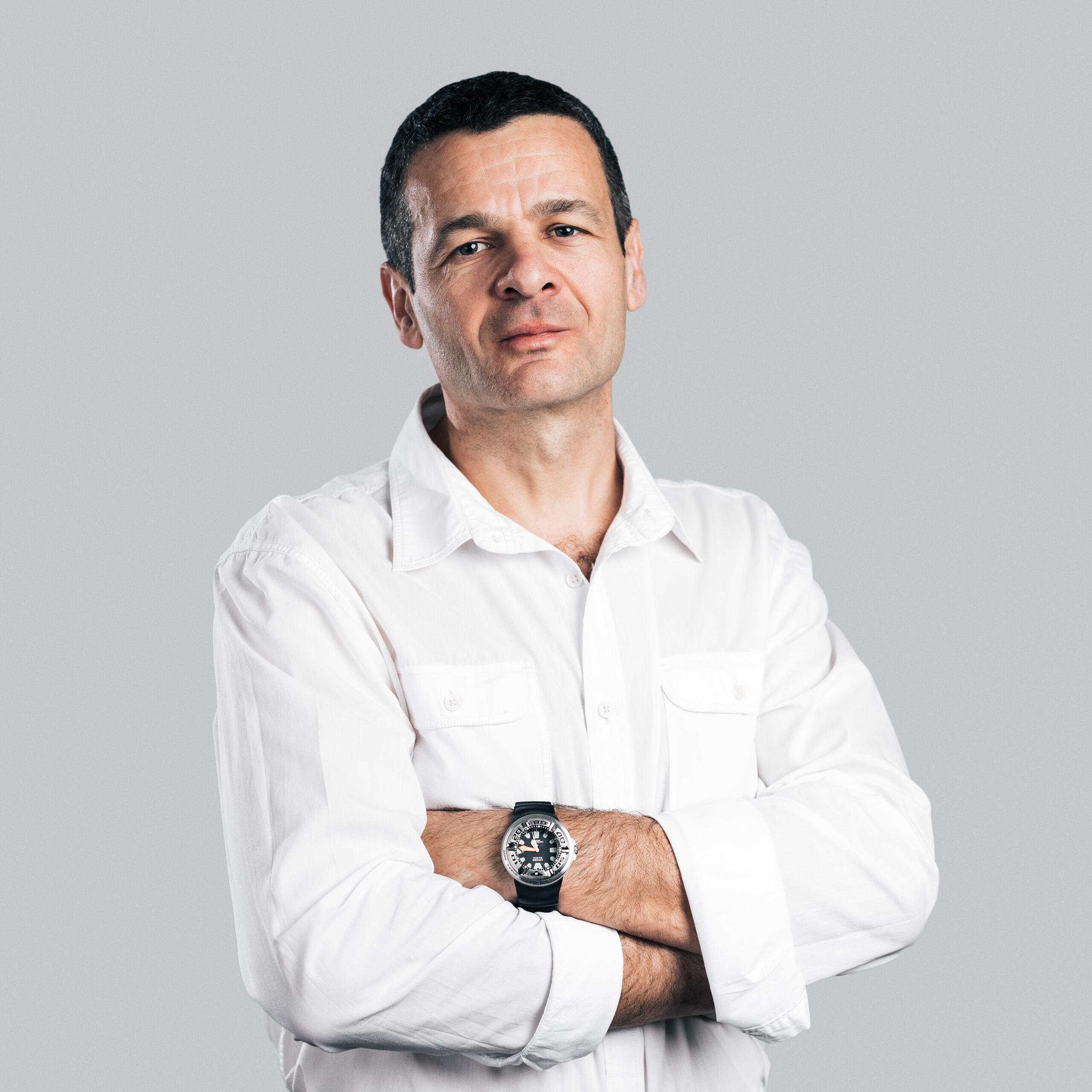
About the author: Hello! I’m Vladimir Stanar, professor of physical education, kinesiotherapist, marathon runner, cyclist, and cycling coach, and long-time advocate of health, fitness, and active living.
My journey with vibration plates runs parallel to my professional career in education, sports medicine, and athletic development. Over time, I’ve come to see vibration plates as one of the most versatile tools for enhancing health, recovery, and performance.
